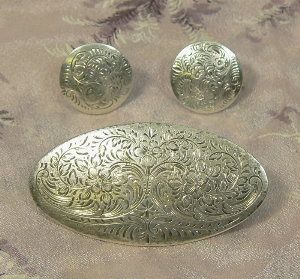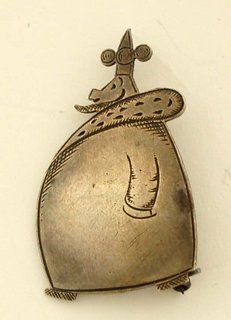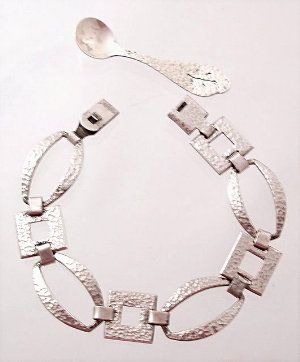Late last year, I stumbled across a small lot of vintage silver jewelry being offered at on online auction (not eBay!). I’ve collected and sold vintage jewelry for years, but had no overriding interest in sterling until discovering one of those obscure treasures we all hunt for (a brooch by Graziella Laffi, Peruvian equivalent to
Imagine my delight when I realized these carried a maker’s mark (likely rendering them more valuable), albeit one unknown to my relatively inexperienced eyes.

I embarked on a mission to find out who had manufactured these pieces. After hours and hours of looking online, typing into search engines myriad guesses as to exactly what this mark represented, eureka--I found it! The mark (a hammer and wings; I don’t know why I didn’t “see” it immediately) was that of the Gaylord Silvercraft shop,
Gaylord Silvercraft was established in the early 1920s as part of the sanitarium’s vocational training and occupational therapy, a means by which recovering patients could learn a skill. It was initially funded by the Federal Board for Vocational Education, and when funding ceased, Gaylord’s board continued the venture, believing that the silverwork would pay for itself. Mr. and Mrs. William Waldo Dodge, Jr. of
Historical records indicate the workshop produced about 140 types of pieces, and about 29,000 pieces in total during its lifetime. They can be sturdy-looking hammered pieces, finely engraved designs, and/or pieces with intricate openwork. All are hand wrought. Apparently the majority of the pieces overall were table silverware and serving items, while the majority of its jewelry pieces were bracelets. Based on what I’ve read and seen, I believe the set I had is extremely rare. I have never seen earrings, and know of nobody who has, although they were indeed made. If you ever find a piece of Gaylord Silvercraft, no matter what it is, buy it! (And I had better go take another look at the balance of that lot I won to see if there are any more gems in there--no more Gaylord, though, I'm afraid....)
Perhaps the best part of my new acquaintance with Gaylord Silvercraft is that, in one of those serendipitous circumstances that sometimes happen in this business, the set, which was listed on A & J Esoterica at
Many thanks to Cathy for allowing me to use the following three photos here:
Old King Cole pin
Hammered-link bracelet and salt spoon
Bon-bon spoon with hammered handle
Note: I’ve compiled this information from numerous publicly available sources, and have cross-checked information as possible for accuracy. I have not lifted verbatim from any source; the organization of the material and writing is mine.




1 comment:
Wonderful article! I'm a big time silver lover as well, and enjoyed learning so much about Gaylord Silvercraft. :)
Post a Comment